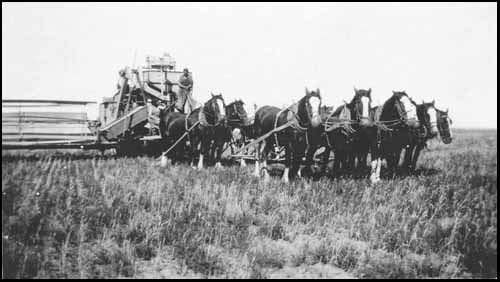The draft horse is an integral element of the history of our province, and Merlin Ford hopes to chronicle that role in a new book.
"It's an interest I've had for quite a while," said Ford who lives in the Kuroki area.
Ford, 39, said he can recall working horsees from when he was a youngster.
"When I was a kid I remember going to visit my aunt and uncle (Graham and Linda Thomson).
They always had a team of Percheron geldings," he said, adding "getting to fed them a can of oats was a highlight of the trip."
And then Ford himself would become directly involved with draft horses.
"My family bought our first draft horses when I was 14, and I started doing a little bit of showing when I was 15," he said.
With an interest firmly set, Ford said the idea of a book began a couple of years ago.
"I got wondering about how draft horse numbers have changed over the years," he said.
As an example Ford said in 1936 5,000 Percherons were registered in the United States. By 1954 it was 54.
Ford related how the decline came into sharper focus when a friend went on a genetics search.
"A friend was looking for a Belgian stallion and his options in Saskatchewan were getting really thin," he said.
So Ford ended up writing a two-page story on the decline of draft horses. He said he quickly realized there was much more story to tell, and the idea of the book was fully realized.
As Ford delved into research for his book he soon determined the story is almost too vast to tell in a single book.
The initial idea was to highlight important Saskatchewan families who played a role in draft horses over the years, said Ford, reasoning community history books already written would be a ready resource, but that idea was soon abandoned.
"There was too much time to cover, and too many people," he said.
Ford has also learned that the human resource for the earliest days of horse use in Saskatchewan are all but gone.
Fortunately he did find some good contacts such as Eddie Arnold of Shoal Lake, MB. He met Arnold at Canadian Western Agribition in 1989 and struck a friendship which last until the senior horsemen's death in 2005.
"He lived to be just shy of 107," said Ford, adding in the years they were friends he shared dozens of stories on horses, in particular those of Saskatchewan horses doing well in the showring at the Toronto Royal and at a major show in Chicago.
"I never met anyone with a memory like that," said Ford, adding " the number of people familiar with this stuff is dwindling as time goes by."
As time passed Ford said he came to realize the story that most needed preserved was the one about the varied roles horses filled over the years in our province.
"I was looking at all the jobs horses did. There were a whole bunch many people had probably never seen," he said.
Ford said most people are at least somewhat aware of horses doing farm work, pulling plows and binders and threshing machines, but at one point they did all the jobs in a city too.
"People think of milk wagon horses," he said, but added basically everything that moved was moved with horses. Goods would arrive by train and then be taken to stores and homes by wagons drawn by draft horses.
Ford said even buildings moved drawn by 20, or more horses.
"People don't realize, or remember that," he said.
Ford said the book will focus on draft breeds, predominantly Belgians, Clydesdales, and Percherons, but will also include Suffolk and Shire.
The Suffolk is an interesting breed, said Ford noting a Stud Book at the University of Saskatchewan listed only about 700 Suffolk from 1907 through to 1939, "and those were the good times (of horse numbers)."
To tell the story of horses doing different things Ford said he knew photographs would be invaluable, and the book is now going to be dominated by pictures, with the text more in support of the visuals. He said he anticipates about 300 photos to make the book, adding "I have a lot more than that."
As for stories, "there needs to be some," said Ford, adding he doesn't want to overwhelm people with story, instead relying on the pictures to draw attention and hold interest.
While Ford said he has access to hundreds of photographs he remains on the look out for others, in particular of draft horses doing jobs within an urban setting. He said tracing families which were involved in using horses in cities and towns is harder.
People with photographs and stories they think might be of interest, or simply wanting to follow progress on the book Ford hopes is released in 2012 can check out www.clippityclop.ca or you can email him at clippity.clop1@gmail or call 338-2132.




